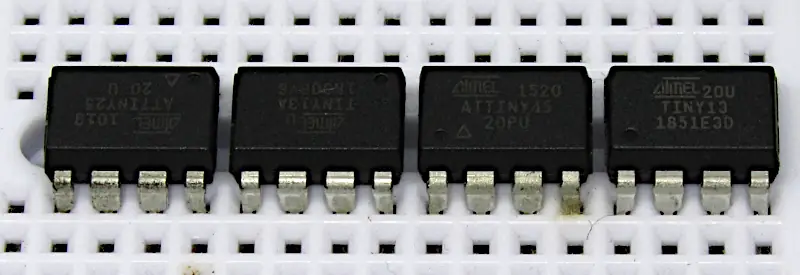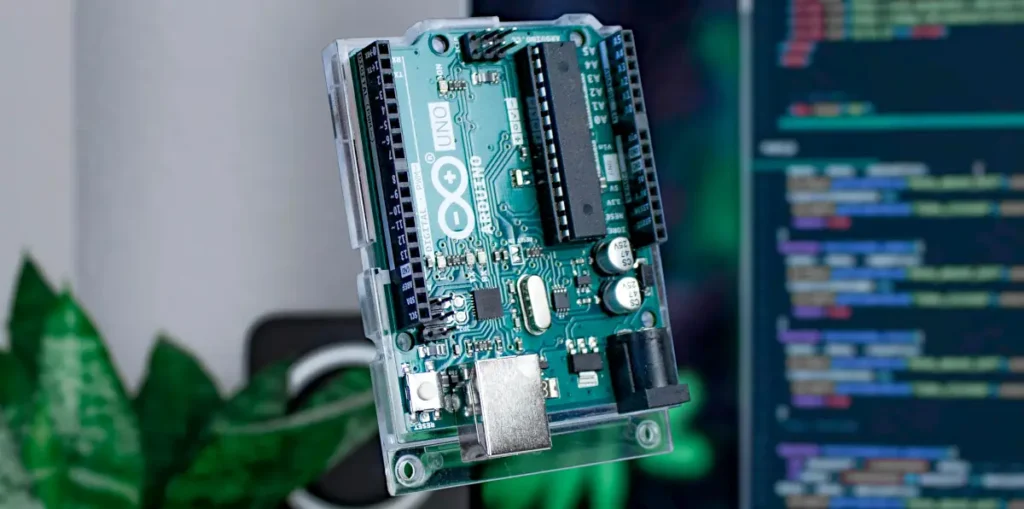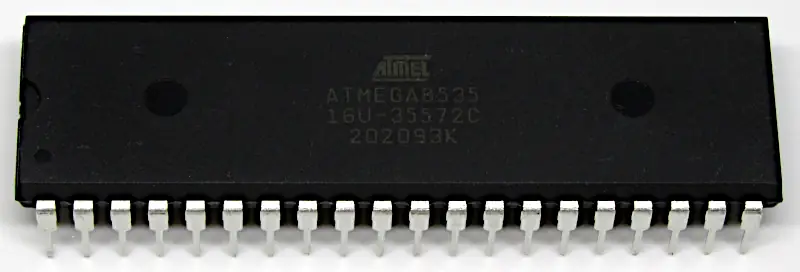8-bit AVR microcontrollers are among the most popular microcontrollers used in embedded systems, hobby electronics, and automation projects. These microcontrollers provide a balance of simplicity, efficiency, and low power consumption, making them an excellent choice for beginners and experienced developers alike. Whether you’re building a DIY project, learning about embedded systems, or designing a professional product, understanding AVR microcontrollers is essential.
In this guide, we explain what 8-bit AVR microcontrollers are, how they work, their history, and why they remain widely used today.
Table of Contents
- The History of 8-Bit AVR Microcontrollers
- What Is an 8-Bit AVR Microcontroller?
- Why Are 8-Bit AVR Microcontrollers Still Popular?
- Popular 8-Bit AVR Microcontrollers
- AVR Microcontroller Families
- Getting Started with 8-Bit AVR Microcontrollers
- Are 8-Bit AVR Microcontrollers Still a Good Choice?
- 8-bit AVR Microcontrollers: Conclusion
The History of 8-Bit AVR Microcontrollers
AVR microcontrollers were first developed in the 1990s by Atmel, a company known for its focus on embedded electronics. The goal was to create a microcontroller that was efficient, easy to program, and capable of executing instructions quickly. Atmel’s 8-bit AVR microcontrollers gained popularity due to their speed, reliability, and built-in features.
In 2016, Microchip Technology acquired Atmel, integrating AVR microcontrollers into its product lineup. Since then, Microchip has continued to support 8-bit AVR microcontrollers, developing new tools and cross-platform development environments to enhance their usability.
What Is an 8-Bit AVR Microcontroller?
An 8-bit AVR microcontroller is a programmable integrated circuit designed to control electronic systems. The term “8-bit” means that the microcontroller processes data in 8-bit chunks, making it suitable for low-power applications, automation, and embedded systems.

Key Features
- RISC architecture for high-speed execution
- Low power consumption, making them ideal for battery-operated devices
- Built-in peripherals, such as timers, ADC, UART, SPI, and I2C
- Wide range of models with different memory sizes and capabilities
- Easy programming using C or Assembly
Why Are 8-Bit AVR Microcontrollers Still Popular?
Despite the availability of 32-bit microcontrollers, 8-bit AVR microcontrollers remain widely used due to their simplicity, affordability, and reliability.
1. 8-Bit AVR Microcontrollers Are Easy to Use
The architecture of 8-bit AVR microcontrollers is designed for simplicity, making them a great starting point for beginners. They have fewer registers and instructions compared to more complex microcontrollers, making them easier to learn and program.
2. Low Power Consumption
Many applications require microcontrollers that can operate efficiently on low power. AVR microcontrollers are optimized for minimal power usage, making them perfect for battery-operated devices and energy-efficient projects.
3. Cost-Effective
8-bit AVR microcontrollers are affordable, making them accessible for hobbyists, students, and engineers designing budget-friendly projects.
4. Strong Community Support
With decades of usage, AVR microcontrollers have a large community of users. This means extensive documentation, open-source projects, and support forums to help new developers get started.
5. Wide Operating Voltage Range
Many devices have a wide operating voltage range, depending on the part. For example an ATmega1284 part has the following voltage specification:
- Operating Voltages
- 1.8 – 5.5V
- Speed Grades
- 0 – 4MHz @ 1.8 – 5.5V
- 0 – 10MHz @ 2.7 – 5.5V
- 0 – 20MHz @ 4.5 – 5.5V
6. High Output Pin Strength
A pin on an 8-bit AVR microcontroller can typically deliver more than 20mA, which is much higher than most ARM microcontrollers. In some circuits this high drive strength can eliminate the need for an additional external component, such as a transistor, which saves cost, board space, and inventory count.
7. Easy to Use Packages
All 8-bit AVR devices are available in one or more different types of surface mount packages. Some devices are available in DIP packages that plug directly into electronic breadboards – ideal for hobby and breadboard prototyping.

Popular 8-Bit AVR Microcontrollers
There are many 8-bit AVR microcontrollers, each designed for different applications. Below are some of the most commonly used models:
ATmega328P: The Most Popular 8-Bit AVR Microcontroller
- Used in Arduino Uno (ATmega 328P) and other development boards
- 32 KB Flash memory, 2 KB RAM
- General-purpose microcontroller for electronics projects

ATmega 328P 8-bit AVR Microcontroller on an Arduino Uno Board
ATtiny85: A Compact 8-Bit AVR Microcontroller
The ATtiny85 is a compact yet powerful 8-bit AVR microcontroller that has become a favorite among hobbyists, makers, and even professionals working on space-constrained embedded projects.
- Small, low-power microcontroller
- 8 KB Flash memory, 512 Bytes RAM
- Ideal for miniaturized and battery-powered projects
ATmega2560: A High-Powered 8-Bit AVR Microcontroller
- Used in Arduino Mega
- 256 KB Flash memory, 8 KB RAM
- Suitable for complex robotics and automation projects
ATmega328, ATmega128, ATmega8, ATmega1284 and ATmega32
Overall, some of the most popular AVR devices are the ATmega328, ATmega128, ATmega8, ATmega1284 and ATmega32, all from the ATmega range. The following list includes some details about these devices and links to information about them on the Microchip website.
- ATmega 328 – this was the Atmel ATmega328 used in the Arduino Uno, and is now the Microchip ATmega328. The ATmega 328P is this same device packaged in a plastic DIP (Dual In-line Package) which is the actual device used in the Arduino Uno that has a chip socket for it.
- ATmega 128 – the ATmega128’s popularity comes from its rich feature set, good balance of performance and cost, and ease of programming.
- ATmega 8 – a solid choice for small embedded systems, hobbyist projects, and simple controllers where the added complexity of a more powerful chip is not necessary.
- ATmega 1284 – available in a 40 pin DIP package which is ideal for hobby breadboard work.
- ATmega 32 – another device that is available in a 40 pin DIP package which is ideal for hobby breadboard work.
AVR Microcontroller Families
AVR microcontrollers from Atmel (now part of Microchip Technology) have evolved over time into several distinct families. Each family offers different features, pin counts, and performance levels to meet a wide variety of embedded applications.
From ultra-small ATtiny chips to powerful 32-bit UC3 devices, AVR MCUs are used by hobbyists and professionals alike. In this section, we explore the major AVR families still in use today, with a focus on the 8-bit AVR microcontrollers that this website is all about.
8-bit AVR Families
The AVR8 architecture is known for its simplicity, speed, and efficiency. These microcontrollers are ideal for embedded systems where performance, power consumption, and ease of use are critical. On this website, we focus on 8-bit AVR microcontrollers because they are beginner-friendly, well-supported by the community, and widely used in hobbyist and commercial projects.
Below are the major 8-bit AVR families you’ll encounter today, namely, the ATtiny, ATmega, AVRxx, and ATxmega series.
ATtiny Series of 8-bit AVR Microcontrollers
The ATtiny family features compact, low-power microcontrollers designed for small, resource-constrained projects. With fewer I/O pins and limited memory, ATtiny chips are perfect for applications like wearables, sensors, and small automation devices. They often come in small packages like SOIC or DIP, making them ideal for breadboarding and DIY projects.
Most modern ATtiny devices now use the UPDI programming interface, replacing the older ISP and High Voltage programming methods. The latest ATtiny microcontrollers are organized into sub-families—ATtiny 0-, 1-, and 2-series—which add new features like improved peripherals, event systems, and more memory options.
Popular models include the the older ISP programmable ATtiny85, and the ATtiny1616, and ATtiny202 from the new series of UPDI programmable devices.
ATmega Series of 8-bit AVR Microcontrollers
The ATmega family is perhaps the most well-known 8-bit AVR series, widely adopted by the Arduino community. These microcontrollers offer a balance of power and features, with more flash memory, SRAM, and I/O than their ATtiny counterparts.
Devices like the ATmega328P (used in Arduino Uno) and ATmega2560 (used in Arduino Mega) are popular choices for more advanced hobbyist and professional projects. Most ATmega chips are programmed using the AVR ISP protocol, with some older chips supporting debugWIRE for debugging.
The image below shows an ATmega8535, which is a 40-pin DIP 8-bit AVR microcontroller from from the older ATmega series.

Microchip has also introduced modernized ATmega 0-series devices that include improved peripheral sets and use the UPDI programming interface instead of traditional ISP. These newer devices offer a more robust feature set while maintaining backward compatibility with existing tools and codebases.
AVR Dx / AVRxx Series of 8-bit AVR Microcontrollers
The AVR Dx / AVRxx series represents the new generation of 8-bit AVR microcontrollers. These chips bring modern features such as configurable custom logic, event systems, improved peripherals, and enhanced CPU performance—all while remaining true to the AVR8 architecture. They use the Unified Program and Debug Interface (UPDI) for programming and debugging, eliminating the need for separate interfaces.
The AVR xx lineup includes multiple sub-families:
- AVR DA: Functional Safety Ready Family of Microcontrollers for Real-Time Control, Connectivity and HMI Applications
- AVR DB: Designed for Demanding Analog Applications
- AVR DD: Designed for Multi-Voltage Analog Applications
- AVR DU: Adds USB support for device connectivity
- AVR EA: Advanced Analog Sensing
- AVR SD: Low-Cost ASIL C/SIL 2-Compliant
- AVR EB: for Motor Control and Analog Sensing
Examples include the AVR128DA48, AVR64DD32, and AVR16EB32. These families are well-suited for both entry-level and advanced embedded projects, offering impressive capabilities in compact packages and with long-term availability.
Some devices in this new series are available in DIP packages, which Microchip calls SPDIP (Skinny Plastic Dual In-Line), which is good news for hobbyists as they fit directly on a standard electronic breadboard. An example is the AVR64DD28 shown in the image below.

XMEGA Series of 8-bit AVR Microcontrollers
The ATxmega family sits between the ATmega and 32-bit UC3 families in terms of performance. These microcontrollers offer features like DMA, event systems, advanced timers, and more communication peripherals. They are ideal for applications that require more processing power and functionality than the ATmega series but still want to stay within the 8-bit realm.
Devices like the ATxmega128A1U are still in production and supported by Microchip. XMEGA chips typically use the PDI interface for programming and JTAG or debugWIRE for debugging.
32-bit AVR Family: UC3 Series
The AVR UC3 family consists of 32-bit microcontrollers based on the AVR32 architecture, which is significantly different from the 8-bit AVR core. These chips offer high performance, advanced peripheral sets, and are suited for more demanding applications like audio processing, USB host/device support, and real-time control.
Although not as popular in the hobbyist world, UC3 devices like the AT32UC3A1512 are still in production and available from Microchip and distributors like DigiKey. However, they are not compatible with 8-bit AVR tools and require a different development approach. For most users interested in classic AVR development, the 8-bit families remain the best choice.
Obsolete Classic 8-bit AVR Microcontrollers
Before the current families took shape, Atmel introduced some early AVR microcontrollers such as the AT90S1200, AT90S2313, and AT90S8515. These classic devices laid the foundation for the AVR architecture but lacked many of the features and refinements of modern chips.
Today, these early AVRs are considered obsolete and have been replaced by newer ATtiny and ATmega models that offer better performance, lower power consumption, and more memory. While you might still find references to these chips in older tutorials or legacy designs, it’s best to use their modern replacements for new projects.
Getting Started with 8-Bit AVR Microcontrollers
To begin working with 8-bit AVR microcontrollers, you need a development environment for writing and uploading programs. Here are some of the best tools available today:
1. Arduino IDE
The Arduino IDE is one of the easiest ways to program AVR microcontrollers, especially for hobbyists and beginners. It supports a wide range of AVR-based boards, including the Arduino Uno and Arduino Mega.
2. Microchip Studio for Windows (No Longer Updated)
Microchip Studio, previously known as Atmel Studio: this Windows-based IDE was designed for AVR and ARM microcontrollers originally from Atmel. While still functional, Microchip has stopped updating this tool, encouraging developers to switch to newer cross-platform alternatives.
3. Microchip’s New Cross-Platform Tools
Microchip now provides cross-platform development tools that run on Windows, macOS, and Linux, making AVR development more accessible:
- MPLAB X IDE – A professional development environment for 8-bit AVR microcontrollers and other microcontrollers from Microchip
- AVR-GCC and AVRDUDE – Open-source tools for compiling and programming AVR chips
- Microchip MPLAB Code Configurator (MCC) – A graphical tool for setting up peripherals and generating code for AVR microcontrollers
Using these tools, developers can now work with 8-bit AVR microcontrollers on any operating system.
Are 8-Bit AVR Microcontrollers Still a Good Choice?
Despite the rise of more powerful 32-bit alternatives, 8-bit AVR microcontrollers remain widely used for:
- Learning embedded systems
- Low-power applications
- Budget-friendly projects
Their simplicity, efficiency, and strong community support make them an excellent choice for both beginners and professionals.
8-bit AVR Microcontrollers: Conclusion
8-bit AVR microcontrollers have played a crucial role in embedded systems for decades. Originally developed by Atmel and now supported by Microchip, these microcontrollers continue to be a reliable and widely used option for electronics projects.
If you’re looking for an easy-to-use, low-cost, and efficient microcontroller, 8-bit AVR microcontrollers are an excellent starting point.
You may be interested in more AVR basics articles on our website.
